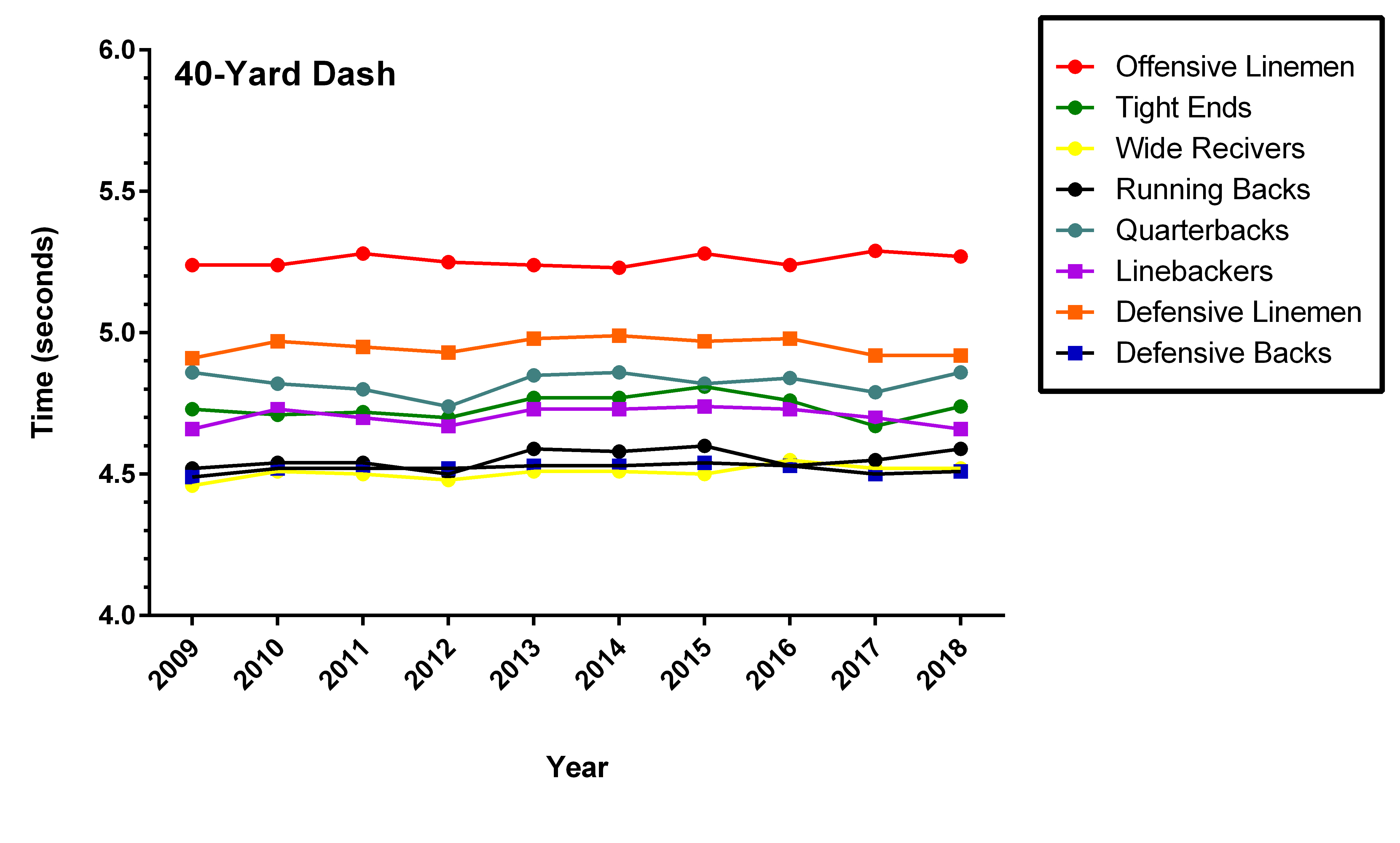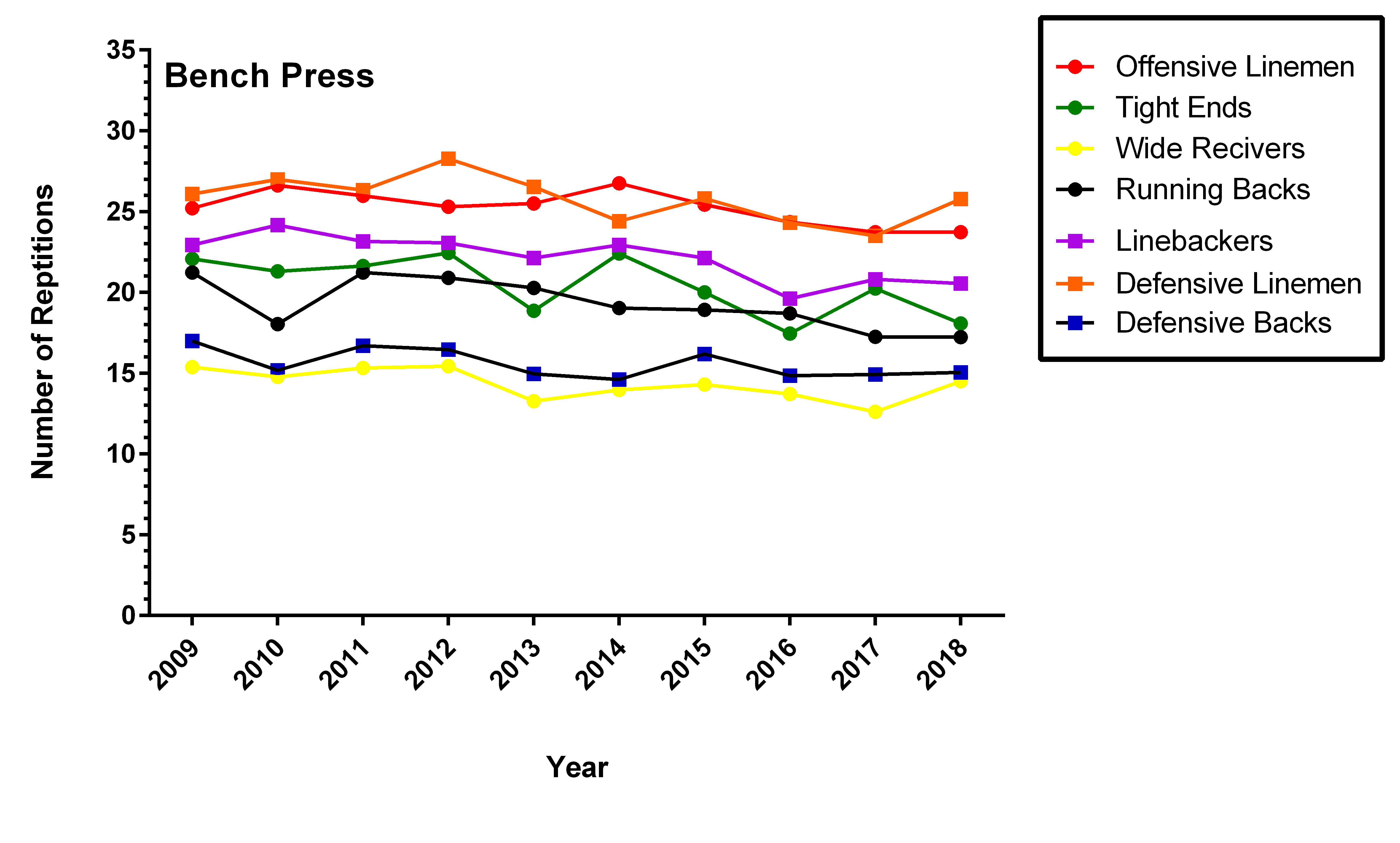Are NFL Combine Invitees Getting Bigger, Faster, and Stronger?
The 2019 NFL Combine just concluded and the athletes seem to be bigger, faster, and stronger than ever before. But, are they really bigger, faster, and stronger than in past years? Data for the last ten years can be found on the website Pro Football Reference. So, let us look at the data and see what has happened to athletes invited to the NFL Combine.
Are athletes invited to the combine getting faster?
Probably one of the most anticipated tests at the NFL Combine is the 40-yard dash. An athlete’s fate in the NFL Draft can literally change by a few tenths of a second difference in their 40-yard dash time. With so much riding on this test, some athletes turn to sprint coaches to help them get a better 40-yard dash time. Therefore, one might expect that 40-yard dash times at the NFL Combine over the past 10 years would have gotten faster. The facts are that by position (i.e., defensive backs, linebackers, defensive linemen, quarterbacks, wide receivers, tight ends, running backs and offensive linemen) 40-yard dash times have virtually remained the same. If you look at the figure below you can see how little change has occurred. While there are differences in 40-yard dash times by position, overall 40-yard dash times have remained constant for the past ten years. Similarly, over the past 10 years, there have been no changes in the time needed to complete the three-cone drill or the 20-yard shuttle run.

Are athletes invited to the combine getting stronger?
The bench press at the combine counts the number of times a player can lift 225 pounds, thus, it is a combination of strength and endurance. Even with all of the changes that have occurred in strength training - personal coaches, new equipment, etc., - the results of this test have remained unchanged. Again, like the 40-yard dash test there are differences by position, however, over the past 10 years the number of repetitions across positions has remained unchanged. You may notice in the figure below that we do not plot quarterbacks. The reason is that from 2013 on, few, if any, quarterbacks actually do this test for the fear of being injured.

Are athletes invited to the combine able to jump higher?
What about jumping higher? Has there been an increase in vertical jump or broad jump for athletes attending the combine? Again, the answer is no. Vertical jump and standing broad jump have essentially remained unchanged for the last 10 years. Looking at the figure below for vertical jump, you can see there are major positional differences in the vertical jump, but when looking across any position, vertical jump height has remained unchanged. The data for the standing broad jump looks identical to the vertical jump.

Are athletes invited to the combine getting bigger?
What about size? Are athletes invited to the NFL Combine bigger today than 10 years ago? Maybe not running backs or quarterbacks, but offensive and defensive linemen must have gotten bigger. Again, when you look at the various positions there has been no change in height or weight. Body mass index (BMI), which is one’s body weight in kilograms divided by their height in meters squared, has not changed in 10 years. This measure is often used to determine if someone is considered overweight or obese. If you look at the figure below, you will see the BMI for all positions has remained consistent since 2009. Now there are differences between positions for BMI; however, within each of the positions, BMI has remained consistent.
What is most interesting is if we use the National Heart, Lung, and Blood Institute’s BMI classifications, all of our positions would be classified as overweight (BMI: 25.0-29.9 kg/m2). Running backs, linebackers, tight ends and both defensive and offensive linemen would be considered obese (BMI: 30.0-34.9 kg/m2) (NHLBI, 2013). The problem with using BMI to classify individuals is that it does not take into account the amount of muscle or fat that actually makes up their body weight. For instance, an athlete could have a BMI greater than 25 kg/m2 and be classified as overweight but actually have a body fat percentage of 8% fat which is considered lean. On the other hand, someone could be the exact same BMI of 25 kg/m2 but have over 30% body fat. Using BMI to classify these elite athletes may not be the most appropriate way to determine accurate body health.

What does it all mean?
Like me, I am sure you expected to see significant changes in times or body size of NFL Combine attendees over the past 10 years. So why no change? One thing to remember is that these are mean averages for each player position. At every NFL Combine, there are outliers who set a new standard for one of the combine tests. This year, the fastest 40-yard dash time was Zedrick Woods, who ran the 40-yard dash in 4.29 seconds (comparable to Oakland Raiders 2010 fourth-round pick Jacoby Ford – 4.28 seconds, but not breaking the record held by Cincinnati Bengals 2017 first-round pick John Ross – 4.22 seconds). It is also important to remember that 10 years ago NFL Combine attendees were already training for the combine, so maybe athletes have reached the limits of what the human body could do in regards to NFL Combine tests. Still, the NFL Combine provides a week to measure, time, and evaluate some truly amazing athletes, and the outliers will continue to set new records along the way.
References
Sports Reference LLC. Pro Football Reference. Retrieve February 14, 2019, from https://www.pro-football-reference.com/play-index/nfl-combine-results.cgi
NHLBI. 2013. Managing Overweight and Obesity in Adults: Systematic Evidence Review from the Obesity Expert Panel. NIH Publication No. 98-4083
About the Authors
Donald Dengel, Ph.D., is a Professor in the School of Kinesiology at the University of Minnesota and is a co-founder of Dexalytics. He serves as the Director of the Laboratory of Integrative Human Physiology, which provides clinical vascular, metabolic, exercise and body composition testing for researchers across the University of Minnesota.
Charles R. Jedlicaka, BS, is a masters student in the Laboratory of Integrative Human Physiology, at the University of Minnesota.